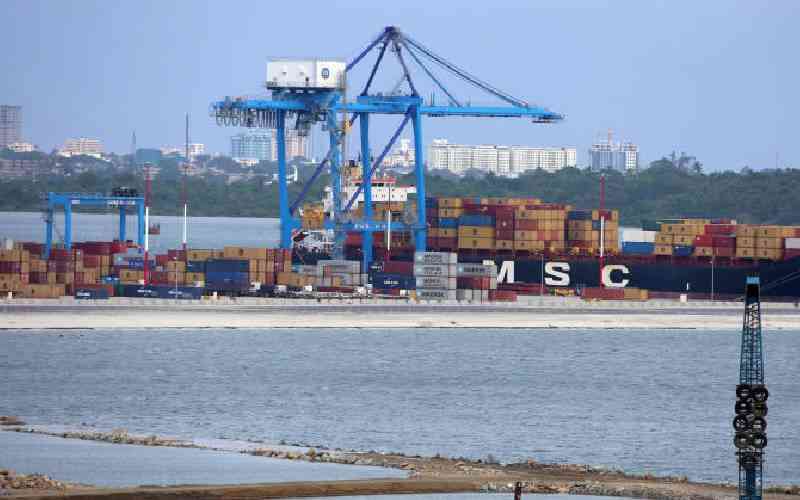
In June next year, the first cargo train will leave Mombasa on the new Standard Gauge Railway. This highly anticipated event, however, may deal a deadly blow to Egypt-owned Rift Valley Railways (RVR).
The capacity of the new line is expected to not only drive long-distance trucks off the roads, but also provide intense competition for freight services on the old railway, which was built before 1900.
The anticipated benefits of the wider and more modern line include slashing transport costs by 60 per cent, and shaving off travel times from two days to eight hours on the higher side.
But amid the relief for most Kenyans is the reality that RVR has invested billions of shillings in the older line after entering a concession agreement with Kenya Railways Corporation for 25 years, ending 2031.
Likely scenarios
Officials at RVR have said their business is protected from any downside, including competition from the newer entrant, throughout the concession term.
This, therefore, begs the question: what will happen to their investment in trains and steel tracks?
“I can tell you for sure our business is protected,” said Sammy Gachuhi, RVR’s general manager, concessions and external communications.
A revised agreement signed with the State in 2010 included clauses that guarantee the concessionaire is cushioned against loss of business from a competing Government-owned railway.
The initial agreement signed in 2006 did not anticipate the SGR, prompting the revision after the then Government mooted the idea of a railway upgrade.
Fears about the viability of the business under the concession played out immediately it became clear that the newer rail had more capacity, and would be the natural choice for traders seeking to move their cargo fast and conveniently, and maybe even cheaper.
One of the likely scenarios, therefore, is that part of the revenues generated by the SGR will be used to settle the compensation as agreed under the terms under the highly confidential concession agreement.
“It [the compensation] could be in cash, or even have us operating some of the business on the SGR,” said Mr Gachuhi.
Apart from the general terms of the concession, which demand RVR surrender 11 per cent of gross revenues to Kenya Railways Corporation for the lease of the track, stations and rolling stock, no other information is readily available.
Stay informed. Subscribe to our newsletter
The best outcome the parties involved could hope for is that there is enough business to ensure the two lines run side by side, and that there are traders who would not mind the slower mode — assuming the costs involved are equal.
But with the anticipation that SGR could cut transport costs by more than half, it is difficult to appreciate the value proposition of the older line for a trader moving cargo.
Gituro Wainaina, the director general of Vision 2030, Kenya’s development programme, acknowledges the likely competition for business between the two railway lines.
“We must look at the bigger picture of growing our competitiveness as a country, rather than how these two railway lines will play it out,” Prof Wainaina said during a recent tour of the SGR.
The role of the Government is to provide an enabling environment for doing business; any other considerations should be secondary, he added.
But RVR, Gachuhi said, is moving a tiny proportion of the cargo that lands at the Port of Mombasa, estimated at only 5 per cent, indicating that even without the protection clauses, there is enough to go around.
“We look at the new line as complementing our business, rather than as competition,” said the RVR general manager, deflecting any fears of a fight for survival.
Moving cargo
RVR is currently modernising its fleet of locomotives and wagons to enhance its competitiveness in speed and freight capacity.
More than 120 new wagons, manufactured in China, are already in operation.
Outgoing RVR CEO Carlos de Andrade said the new equipment had significantly enhanced the firm’s capacity, especially in moving cargo.
“So far, we have been limited as regards the volume of freight we are able to move because of the size and quality of the wagons we inherited, many of which were built more than 30 years ago.
“For the first time since we took over the concession, RVR will be deploying wagons that are purpose built for modern rail transport operations, both in terms of capacity and their condition.”
He added that the new wagons were “a lot more cost effective”, possibly placing his firm in better standing to compete for customers with the new rail.
RVR has also undertaken major repairs on the track to enable trains move faster along the 500-kilometre stretch between Mombasa and Nairobi.
How much faster trains can move on the metre-gauge line could be the critical factor in decision making among exporters and importers.
Top Government officials have said the new line, the hallmark of President Uhuru Kenyatta’s first term, would not be handed over to a concessionaire as was the case with RVR.
An experienced operator will instead be contracted to run the cargo and passenger business.
“We as a corporation do not yet have the capacity to operate the business,” Atanas Maina, the managing director of Kenya Railways Corporation told Business Beat, but said the firm was clear about the profile of the prospective operator.
A breakdown of the capacity of the SGR line could perhaps paint a clearer picture of how much of a difference there would be in moving freight and people.
With the installation of more than 30 crossing stations — which are essentially sections with multiple tracks — several trains could be moving along the Mombasa-Nairobi stretch in either direction at any one time.
Engineers managing the construction of SGR estimate that 20 trains could be running simultaneously, through a 24-hour cycle. Only four will be passenger trains, while the rest will be slower-moving cargo trains.
STAGING PROTESTS
Passenger trains are projected to move at 120 kilometres per hour, while the speed for cargo trains will be capped at 80 kilometres per hour — which is still four times faster than average speeds on the old rail.
Each of the trains on the SGR has the capacity to move 100 containers, equivalent to the cargo moved by as many average trucks.
It is a prospect that has jostled truck owners and crew, with some staging protests over the impending loss of jobs once the new rail is completed.
Transport and Infrastructure Cabinet Secretary James Macharia has, however, moved to ease these fears, saying there still exist opportunities for truckers to get into organised investment groups and possibly operate cargo trains on the new line.
“We see the SGR opening up opportunities for everyone,” he said while inspecting the last bridge in Athi River area, just outside Nairobi.
Mr Macharia also allayed fears that the new rail would disadvantage the older line and its operator, RVR.
While he believes the SGR will significantly reduce business opportunities in moving cargo by road, it would not take up all projected two million containers expected to land at the Port of Mombasa each year.
A lot more cargo, including steel rolls, cars and grains, are often not imported in containers — meaning that there is more cargo to be moved than the new rail could ever accommodate.
A new container terminal, with enhanced features and capacity, was commissioned last month at the point where the SGR will terminate, giving the new line an edge over the old one.
Kenya Ports Authority (KPA) projects the second container terminal will clear more cargo than the older one at Kilindini. The possibility is that containers could in the next two years be offloaded directly from ships onto trains for onward transmission to the hinterland.
Such an arrangement would further reduce handling and storage costs for importers and exporters, enhancing the attractiveness of SGR.
KPA handled 26.7 million tonnes of cargo last year, a nearly 8 per cent increase from 24.9 million tonnes reported in 2014.
In container traffic, the Mombasa port handled a total of 1,076,118 20-feet-equivalents up from 1,012,002 in 2014.
Acting managing director of KPA, Catherine Mturi, said port traffic was growing at a “fast rate”.
More than 95 per cent of this cargo was, however, moved by road, even though it is the costlier option when compared to the metre-gauge railway.
But in the likelihood that the SGR takes a huge chunk of the road transport business, as well as the share enjoyed by the old rail, Kenya could be left in a precarious situation, compensating RVR for lost business and several hundred kilometres of unutilised old track.
[email protected]
 The Standard Group Plc is a
multi-media organization with investments in media platforms spanning newspaper
print operations, television, radio broadcasting, digital and online services. The
Standard Group is recognized as a leading multi-media house in Kenya with a key
influence in matters of national and international interest.
The Standard Group Plc is a
multi-media organization with investments in media platforms spanning newspaper
print operations, television, radio broadcasting, digital and online services. The
Standard Group is recognized as a leading multi-media house in Kenya with a key
influence in matters of national and international interest.
 The Standard Group Plc is a
multi-media organization with investments in media platforms spanning newspaper
print operations, television, radio broadcasting, digital and online services. The
Standard Group is recognized as a leading multi-media house in Kenya with a key
influence in matters of national and international interest.
The Standard Group Plc is a
multi-media organization with investments in media platforms spanning newspaper
print operations, television, radio broadcasting, digital and online services. The
Standard Group is recognized as a leading multi-media house in Kenya with a key
influence in matters of national and international interest.









